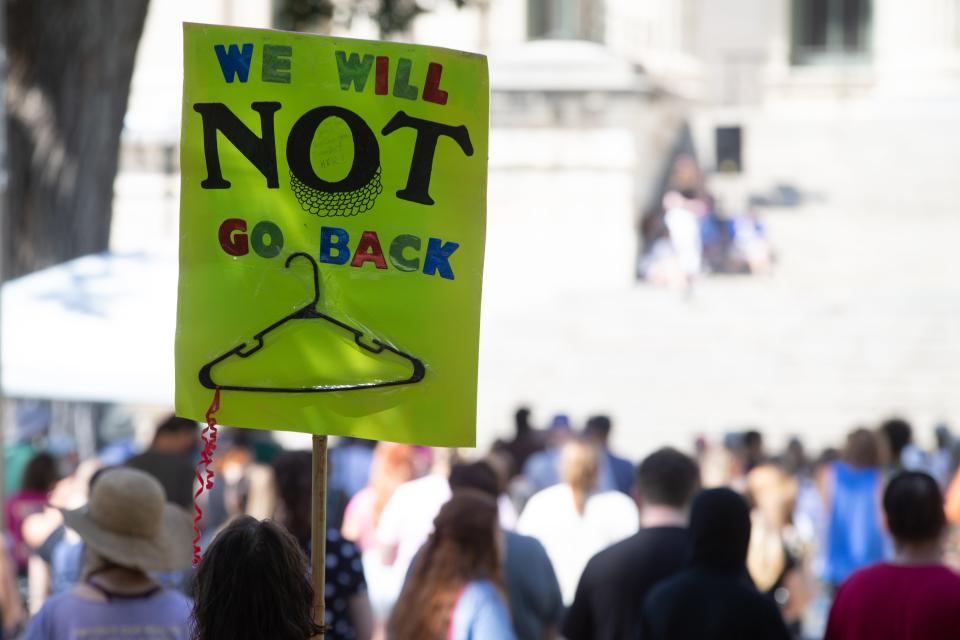Abortion patients streamed to Kansas after Roe was overturned. Here's what numbers show.
In the months after the U.S. Supreme Court overturned Roe v. Wade, abortion bans in other states have nudged pregnant women and girls to turn to Kansas, causing the state's abortion numbers to hit a 21-year high.
Women and girls from Oklahoma, Texas and Missouri turned to Kansas by the thousands, according to 2022 abortion statistics released Friday by the Kansas Department of Health and Environment.
The 12,317 abortions performed in Kansas in 2022 was the most since 2001 and a 57% increase from the 7,849 abortions in 2021. But that increase is entirely due to out-of-state patients, with the number of Kansas patients dropping to 3,843 from 3,912 in 2021.
The increase in out-of-state patients came after the U.S. Supreme Court's decision in the Dobbs case overturned Roe, allowing states to ban or heavily restrict abortion, as Oklahoma, Texas and Missouri all did.

Kansas politicians have not pursued an abortion ban because the Kansas Supreme Court's Hodes decisions, ruling the state constitution protects the right to an abortion. Voters in August overwhelmingly rejected the proposed Value Them Both constitutional amendment to undo the court's decision.
"As we predicted, Kansas has seen a massive increase in the number vulnerable women being intentionally funneled to abortion facilities in Kansas," said Danielle Underwood, a Kansans for Life spokesperson. "Behind each of these statistics is an industry eager to pad its bottom line, a woman who has been pushed to feel she has no other option, and a child who will never blow out her first birthday candle."
The KDHE's report was released several weeks later than they historically have been, coming one day before the one-year anniversary of the Dobbs decision.
"Today serves as a somber reminder of the overwhelming loss of Roe and its impact on patients’ fundamental right to control their bodies, lives, and futures," said Emily Wales, president and CEO of Planned Parenthood Great Plains. "For the past year, we have lived through the challenges this man-made health crisis has created for the region."
Planned Parenthood opened a new clinic in Kansas City, Kansas, last summer intended to help meet the demand from out-of-state patients.
"Like most Kansans, as we saw last August, Governor Kelly continues to believe that women have a right to make their own private health care decisions," said Zach Fletcher, a spokesperson for Gov. Laura Kelly.
Voters in the Aug. 2, 2022, primary election voted 59% to 41% against Value Them Both. Republican politicians who supported the amendment have maintained that it was not a referendum on abortion restrictions more broadly.
"The abortion statistics are a sobering reminder of the consequences from the disastrous Hodes decision," said Senate President Ty Masterson, R-Andover, who vowed to "continue to pursue protections for children in the womb through common sense policies supported by the vast majority of Kansans."
Where were Kansas abortion patients from
Here are the top 10 states of residence for patients of abortions performed in Kansas:
Kansas: 3,842.
Texas: 2,978.
Missouri: 2,883.
Oklahoma: 2,026.
Arkansas: 405.
Louisiana: 88.
Nebraska: 12.
Mississippi: 10.
Tennessee: 10.
Florida: 8.
Here are the top 10 counties of residence for Kansas patients:
Sedgwick: 1,013.
Johnson: 842.
Wyandotte: 485.
Shawnee: 262.
Douglas: 172.
Geary: 89.
Riley: 82.
Saline: 53.
Reno: 51.
Butler: 50.
How far along were the pregnancies
At 60%, the majority of abortions were formed before nine weeks gestation, and likewise the abortion pill mifepristone, which is most effective early in a pregnancy, was the most common method of abortion at 60%.
Another 29% were between 9-12 weeks, with 8% from 13-16 weeks and 4% from 17-21 weeks.
Suction curettage accounted for 34% of abortions, with dilation and evacuation accounting for 5% and induction 1%. Less than 1% used methotrexate or sharp curettage. Dilation and evacuation, which is a common procedure for second trimester abortions, is referred to by abortion proponents as dismemberment.
More: Kansas abortion clinic sues FDA over access to mifepristone pills used in telemedicine
First late-term abortion in Kansas in years
For the first time in four years, the state reported an abortion at or after 22 weeks gestation. That is the point an abortion is considered late-term under state law, though that isn't a medical term.
The state reported five such abortions in 2018, but all five were Kansans who traveled outside the state for their procedures. Not since 2016 has a late-term abortion been performed in Kansas.
The one such abortion this year was performed on an out-of-state resident with a nonviable pregnancy.
"Pregnancy had agonal fetal cardiac activity not compatible with life and no fetal movement," the report said.
The report also said the abortion was necessary because, "substantial physical and irreversible impairment/death would result if left untreated as infection/hemorrhage likely."
More: Amid lawsuit, state won't enforce abortion pill reversal disclosure in Kansas for now
More Kansas abortion data
Kansas reported 300 abortions where the patient was a child, including 10 girls who were younger than 14, which would constitute statutory rape.
More than half of the abortions were women in their 20s. There were also 29 abortions where the patient was 45 or older.
The reports also show 14% of patients reported being married, 30% had never been pregnant before, 41% had no children, 69% had never had a previous abortion and 81% had never had a miscarriage.
Medical providers filed reports of physical, mental or emotional abuse or neglect in 76 cases.
More abortion statistics are available online from the KDHE's public health division. Annual reports date back to 1998.
This article originally appeared on Topeka Capital-Journal: Kansas 2022 abortion report shows effects of Supreme Court decisions

